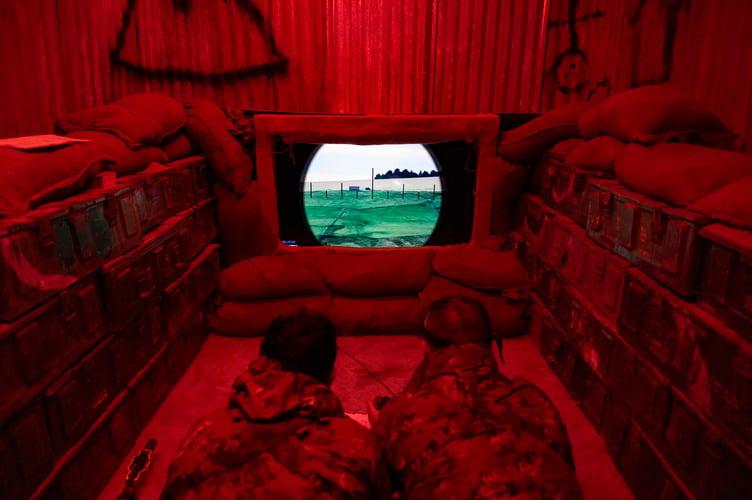Soldiers from across the world have faced up to the ultimate challenge of military fieldcraft, navigation, tactics, leadership skills and teamwork.
This all took place across the undulating terrain of Bannau Brycheiniog (Brecon Beacons) where Exercise Cambrian Patrol has had its roots since 1959.
Nearly 1,000 troops, spread across eight phases of the event, were set a mock mission that includes covering more than 40 miles from Crickhowell to Sennybridge, dealing with enemy threats and other challenges.

Lieutenant Colonel Will Peltor, Officer-in-Charge, said: “As we mark the 65th year since the first Exercise Cambrian Patrol took place it’s important to note that the event maintains its core standards and is as relevant today, in the modern operational environment, as it was for Territorial Soldiers nearly seven decades ago when they were being tested on their Cold War readiness.
“The responsibility for retaining the spirit of the exercise, while modernising it through the years, resides with the British Army’s headquarters in Wales at 160th (Welsh) Brigade.
“We plan and deliver the eight phases on behalf of the Commander of the Field Army, in line with the training direction of Director Land Warfare Centre. This year 113 patrols have entered, with 42 Regular, 18 Reserve, 15 University Officer Training Corps and 38 international, including two joint patrols.”

The exercise involves eight-person patrols advancing across challenging terrain, conducting numerous tasks which reflect the British Army’s training priorities within the soldier-first syllabus and individual training requirements.

Patrol commanders received a set of orders based on a specific scenario involving enemy forces, for onward briefing to members of their patrol.
They then battle prepped and selected a designated route, along which they navigated through day and night and then completed a set of tasks.
These included medical treatment and casualty evacuation scenarios; clearance of safe lanes through minefields; intelligence gathering; seeking protective measures against chemical, biological, radiological and nuclear (CBRN) threats; a water crossing; employment of artillery fires and vehicle recognition; close-target reconnaissance; a section attack and prisoner of war handling.

This year the CBRN task took place at the disused Trefil quarry, a well-known location for Hollywood production companies keen to make use of the dramatic landscape there.
The patrols completed the exercise by writing a report and recall all key information at the debrief, which forms part of the scoring process to assess whether they were to be awarded a gold, silver or bronze medal, or a completion coin.
Exercise Cambrian Patrol is now very different to how it started in 1959 when a group of Welsh Territorial Army soldiers designed a weekend training event featuring long distance marching over the Cambrian Mountains, culminating in a shooting match on the Sennybridge Training Area.

Lt Col Peltor said: “This year the exercise aimed to build upon the focus of core soldiering, a theme for the last few years, also exposing patrols to an element of the uncertainty and dynamic threat of the modern operating environment.
“There was an increased presence of unmanned air systems (UAS), in addition to other new or emerging training technologies and equipment, subsequently enhancing operational capability and supporting innovation and experimentation.
“Highlights this year were the opportunity for patrols to integrate with UAS to assist in the completion of some tasks, as well as negotiating how they move across ground against the backdrop of a heightened enemy UAS threat, as well as exposure to an array of enemy vehicles.
“Much of this has been achieved in collaboration with Defence industry and contractors, who now form an increasingly key component to ensuring the exercise retains its world-class calibre.
“In what is the 75th anniversary since NATO’s formation, it is appropriate Cambrian sees both NATO and non-NATO interest in the exercise expanding, with nearly 40 international patrols from 35 countries participating, with joint patrols once again featuring.
“The international dimension is key for both raising the standards and the performance of patrols, which is important in sharing best practice, as well as acting as good preparation for the realities of multi-national operations and deployments across the world.”

Brigadier Nick Thomas CBE, Commander 160th (Welsh) Brigade and head of the Army in Wales, said: “We are incredibly proud Exercise Cambrian Patrol has entered its 65th year and has continued to evolve to provide relevance and utility in meeting the needs of the British Army and our allies, championing dismounted section-level patrolling excellence.
“This continues to give the British Army the ability to dip-test and assess where it sits on the core skills of soldiering and how it provides a platform for experimentation and innovation, with the added bonus of affording us the opportunity to work alongside our allies and partners.”
“None of this would be possible without the support of the subject matter experts from across the Field Army who assist in planning and designing the tasks, as well as the industry partners who provide some of the latest equipment and technologies,” added Brigadier Thomas.
“Fundamental to the success of this event has also been the people and landowners of Wales who have allowed the army to host this iconic exercise for more than six decades.”



-said-the-grant-will-make-a-real-difference-in-helping-tackle-child.png?width=209&height=140&crop=209:145,smart&quality=75)

